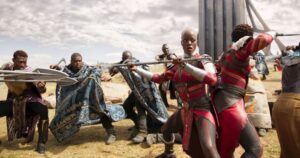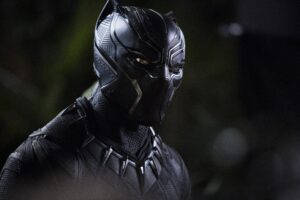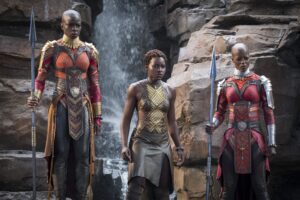
You know the drill. You buy the tickets, get the popcorn, settle into your seat, resist the previews — you’re seeing a Hollywood movie. But something interesting has been happening in Hollywood over the past 10 years or so. In the wake of cinematic aberrations such as The Help and The Longest Yard, a new mood has been on the rise in Hollywood’s treatment of Black subject matter that emphasizes the centrality of Blackness, but addresses it with all of the characteristic flair of any Spielberg or Coppola film. Much is said about the language surrounding Black identity, but not enough about aesthetic, and by extension, moral and ethical treatment of Black Americans. Black Panther delivers up a dish in spades, one to savor, one to enjoy again and again.
When I saw the trailer for Black Panther several months ago, I knew something major had happened before my eyes and behind the scenes. I remember Black Panther comics as a kid. He was someone I thought of as a not necessarily minor character in the Marvel universe, but not Spiderman or the Avengers either but who was always treated with care and dignity.
It was dark in the theater as I was blindly taking notes, and these are the talking points I came up with:
Technology Concealment Afrofuturism
the 1970’s Colonialism Black is Beautiful
“ghetto” vs. “African” speech
I want to start seemingly out of order, by addressing the last point on speech and articulation. The film’s treatment of dialect is important to note. The villain is born of inner city violence. He wants to transform Wakanda, the mythically advanced African country, into an agent for Black Liberation worldwide since the isolationism of the country has caused it to fail to protect and defend others. The way he speaks is familiar to ‘us’. It is threatening, uneducated, violent. He exudes his strength through this brand of necessary violence, a violence that is somehow relatable, even desirable. The protagonists, on the other hand, speak with the affectation of educated people, people whose first language is not English — people one may have encountered in a restaurant, board meeting, or college classroom. This use of speech is the entry into the inner lives of the film’s characters; it helps us separate the good guys from the bad guys. It’s what makes the characters relatable, alluring, identifiable with one’s own higher self. The use of speech also lends a hand in towing the party line that the film promotes, that the status quo of international relations is fine as it is, that there is nothing wrong with the world that cannot be fixed through peace and diplomacy, the clarion call of our gentle America-first Eurocentrism. But for many this vision of the world is as fantastical and implausible as the existence of Wakanda itself. Another obvious observation that must be made has to do with the treatment of the white characters. Whiteness is not treated with out-right irreconcilable villainy – much to the film’s credit. Whiteness itself is treated with just as much complexity as blackness, a facet of the film that might be lost on some viewers (especially in scenes of overt black/white violence) because it shows European people from a frame of reference outside of their own. The film is laced with barely perceptible ticks, lines such as “you’ve been watching me since you came in here but you don’t pay attention to what you put into your own body”, spoken to the African Art curator (perhaps a nod to veganism/anti-racist rhetoric), muttering of the word “Americans” by the protagonists in the casino directed at the white patrons.

While the cast of characters is almost ALL black, Black Panther is primarily a film for black and white, and non-black and non-white people to watch together, that treats Black subjects with dignity. It is a sci-fi futuristic epic about tradition, change, good and evil, redemption, the rise of a savior and the triumph of basic human goodness — the standard Hollywood fare, nothing really outstanding; but Panther is not notable for its screen craft, its costumes or even its special effects. It’s notable because, like more recent releases such as Django Unchained and Get Out, it is memorable. The original Black Panther comic was very much a creation of the 1960’s that seemed to fade but remained rooted in the Marvel universe. The comic and the film speak to what we in the alleged post-colonial world so desperately want to believe, that western civilization did not completely crush those who were victimized by it the worst. That somewhere, there must be a culture that is noble, resilient and just as innovative as those we are striving to become. A civilization that charted its own course to modernity without coming to the brink of self-destruction by respecting time-honored traditions. So what happens when those traditions turn against the society that created them and the winds of change sweep over the beloved country? This gives the film its ultimate edge. Wakanda which survived and thrived for millenniums, is finally under threat of being conquered, colonized and exploited for its natural resources, and its very traditions will be the instruments of its demise.
I think with Black Panther we have reached the apogee of a phenomenon in American Culture that one can casually think of as a Reinvention of Blackness carried out in public. The programs of integration that have failed to deliver change for vast swathes of the Black population, and within which integrated African-Americans have found racial animosity on the right and racial paternalism, condescension and callous ambivalence from corners of the left is intensifying. This is a phenomenon that predates Obama, and was borne of the dissolution of Post-blackness and the gentrified boutique subtle racism of the millennial hipster generation, my generation, with VICE magazine as their spiritual pornography and American Apparel and Salvation Army providing their uniforms.
There is a new celebration of Whiteness reflected in the perverse obsession with period films depicting moments in history where black representation is totally excluded as unnecessary to create fantasies for closet racists, who are essentially what many, many, many Americans are (think Lincoln or The Beguiled). This American impulse has engendered a counter-reclamation of Blackness among a segment of the population that was taught that we had finally arrived and were “All Americans Now”, and that validates the rhetoric of Afrocentrists who say Americans were too racist to ever accept black people in the first place, an attitude that was disparaged and rebuked by the New Left in the 80’s and 90’s, yet has been adopted by the progenitors of that cultural movement during a moment of nihilistic euphoria that has been on the rise since the mid-oughts.
If you look at the general population, it appears that a significant number of white Americans seem to be bored with chants for “equality”, bored with multiracialism, multiculturalism, and waiting for other races to “catch up”, and have now lashed out with a more sophisticated form of bigotry that is “too smart” to simply be labelled as such outright and is broadly tolerated if not encouraged by others on both the right and the left. Many of those who lived a life relatively free of the barbs of racism up until now feel like outsiders in American society.
But back to the movie. The politics of Black representation engendering more human visions of African-Americans have been playing out in

Hollywood in a moment that I think starts in the late 80’s into the 90’s. It lay dormant for a while, but came back with a vengeance in Quentin Tarantino’s Django Unchained. After the release of 12 Years a Slave in 2013 it was clear that there was a new paradigm in Hollywood emerging, one that treats African-Americans in stark contrast to films such as Lincoln that betray nuances of acceptable racism that are not potent enough to smear the exceptionalism of American whiteness. Django, which came out at the same time as Lincoln, tears that fetishized whiteness down in tantalizing baroque forms of extravagant violence, and was, like Panther, a movie that appeared to transcend itself in the popular imagination, as indeed many of these films of the 10’s appear to do.
This new accelerated generation of films centralizes blackness and attempts to discard the animosity that is frequently the handmaiden of black representation, and (since it’s Hollywood) serves as a gentle reminder that validates the humanism that binds us together.
This new moment, It’s not about black nationalism, separatism, or futurism. It is a covertly interracial programme occurring apparently in Hollywood and the high art world as well that amounts to being a counter to an aesthetic movement that, once again, privileges white identity above all others. Matt Damon in The Wall, Sofia Coppola’s The Beguiled. Black People, and others, everyone else who is not white have felt themselves betrayed by the inheritors of the cultural liberalism as well as the MAGAs, and like Get Out have to fight for the right to exist after falling for a kind of social/cultural trap.
Black Panther, Django, 12 Years, Get Out, Fences, Hamilton, Detroit, Belle, Selma, Hidden Figures, and before that The Color Purple, Beloved, Malcolm X and Glory are popular films, not art house accretions of a more humane vision of black representation. Panther, and other so-called black films, are manifestations of a unified culture that elevates the necessity of Black identity in America for the interest of self-preservation and to release white people also from the legacy of bigotry that has defined them.
Black Panther, I hope, shows all of us something that we desperately wish existed, that lies just over the horizon, a collective hallucination writ large and made for everyone. Not necessarily as a work of Art or artistically great Cinema (as it’s based on a Marvel comic book), though I am certainly open to debate about that, but as an overt reclamation of basic human dignity. I hope it asks us to find Wakanda within ourselves and see it in each other. I hope Black Panther teaches us that as long as we live, as long as we stare down our fears in the face of overwhelming evil, even if we fail, we will have failed better than our victors have triumphed, and accomplished something more meaningful than our oppressors. We will have kept the waters troubled, and stood up to demand our right to be seen as who are, or at the very least, who we strive most to be.
Spencer Hutchinson, Chicago Editor
Spencer Hutchinson is graduate from The School of the Art Institute of Chicago (SAIC). He is a student at the University of Chicago as well as a member of the Borderbend Arts Collective and is a founding member of Agitator Co-operative Gallery in West Town.
Since 2014 he has been working heavily with found objects in the conceptual/ neo-dada vein of artists such as David Hammons, Jasper Johns, Joseph Kosuth and Marcel Duchamp.
One of Hutchinson’s current ongoing projects is a serial piece called “I See My Light Come Shining” that focuses on issues pertaining to Black racial identity and social history through the use of sound and found objects. Spencer Hutchinson lives and works in Chicago.
volume 32 no 5 May / June 2018 pp 8-10

What a powerful message the author of this article gives with his conclusion: “I hope Black Panther teaches us that as long as we live, as long as we stare down our fears in the face of overwhelming evil, even if we fail, we will have failed better than our victors have triumphed, and accomplished something more meaningful than our oppressors. We will have kept the waters troubled, and stood up to demand our right to be seen as who are, or at the very least, who we strive most to be.”
We need more writings like this!
Thank you.
Is this the next cultural context of the US? I hope not!
https://www.rt.com/usa/430957-america-new-civil-war-trump/
I will be a cloud and rain on this parade. I started watching Black Panther and had to stop after 5 minutes. I was really looking forward to an amazing flick just from the graphics, the visuals, the aesthetics. But it’s a movie made for tweens and very young teens who haven’t read much history, it’s like a Ben Hur movie where everyone wears brand new clothes and hollywood hair styles when realism would say they be sweaty and dirty.
Good comment Miklos; I totally agree with you.